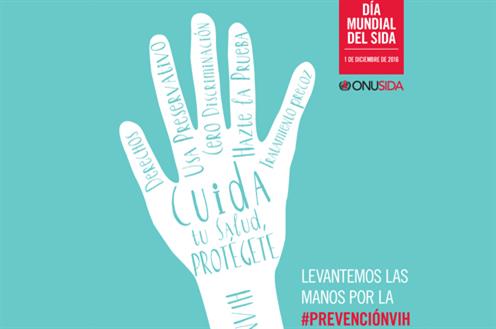World AIDS Day was held on 1 December, the date set by the World Health Organisation and the United Nations AIDS Organisation (UNAIDS) to strengthen the response to this epidemic, which is supported by governments around the world.
This year, the Ministry of Health, Social Services and Equality is joining the UNAIDS campaign aimed at the general population under the slogan “Hands up for #HIVPREVENTION”. The campaign seeks to promote prevention strategies and foster the early diagnosis of AIDS in order to achieve the UNAIDS targets for 2020 and 2030.
Through the Spanish National AIDS Plan, the Ministry of Health, Social Services and Equality designs and implements an annual campaign aimed at the general population at this time of year in partnership with the regional governments and NGOs. The slogan has been distributed to all the regional governments and NGOs that work with HIV for incorporation into their statements and for them to spread it on the social media networks.
The goal of this campaign is also among the prevention objectives of the Strategic Prevention and Control Plan for HIV and other STIs 2013-2016: to increase knowledge about these diseases, to reduce the number of new infections and to make an early diagnosis of those who are infected with the disease but are unaware.
It is estimated that between 130,000 and 160,000 people currently live in Spain with the HIV infection, of whom approximately 20% to 25% have not been diagnosed.
A total of 3,428 new HIV infections were diagnosed in 2015. It is estimated that the rate for 2015 will be 9.44 per 100,000 inhabitants when information has been received on all the diagnoses made that year.
The majority of new diagnoses were among men (85.9%) and the average age of the person diagnosed was 36.
The most common form of transmission is sex, accounting for 79% of all cases (53.6% in men who have sexual relations with men (MSM) and 25.4% in heterosexual people). The percentage of cases in which transmission took place in people who inject drugs (PID) continues to fall (2.8%).
The majority of new diagnoses were discovered in the 30-39 age group (33.8%), although it is worth noting that 14.4% were aged 50 or above.
46.5% of new diagnoses in 2015 were made late. Most of the late diagnoses were made in heterosexual men (63.1%). Furthermore, the delay in detecting HIV rose significantly with age, up to 63.2% in those over 50 years old.
New diagnoses in people born outside of Spain fell from 40% in 2009 to 30.3% in 2015. The most common regions of origin were Latin America and Sub-Saharan Africa.
In order to offer free and confidential information, the National AIDS Plan of the Ministry of Health, Social Services and Equality provides a Multichannel Information and Prevention Service on HIV (Spanish acronym: SMIP), which is managed by the Spanish Red Cross. Since this service was launched over 10 years ago, more than two million contacts have been made by telephone, web chat, visits to the website, email and impressions on the social media networks.
Men continue to request information on all channels in greater numbers than women: men account for 85% of calls, 65% of web chats, 58% on Twitter and 55% on Facebook.
Those aged between 25 and 35 are the most likely to contact this service. 65% of contacts via Facebook are under 35 and 2% are children. The main reasons for contacting the service are to seek information on transmission (50%) and HIV tests (30%).





